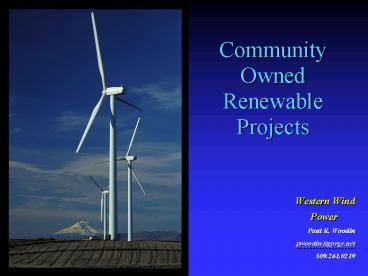Community Owned Renewable Projects - PowerPoint PPT Presentation
1 / 17
Title:
Community Owned Renewable Projects
Description:
Non-taxable and does not pay property taxes. For-Profit (Equity Flip) 30% equity, 70% debt. ... Community is not equity investor because they are non-profit entities ... – PowerPoint PPT presentation
Number of Views:37
Avg rating:3.0/5.0
Title: Community Owned Renewable Projects
1
Community Owned Renewable Projects
- Western Wind
- Power
- Paul R. Woodin
- pwoodin_at_gorge.net
- 509.261.0219
2
Community Renewable Projects
- Wind, Bio-mass, bio-diesel, ethanol plants,
geothermal, solar, etc. - These projects are common in Mid-west just
coming to Oregon - 1- 10 MW renewable projects
- Larger for some geothermal and co-gen facilities
- Tied into local utility lines
- Ownership and revenue remains local
- Businesses that keep ownership and profits local.
Compliments current farm and timber practices in
rural Oregon - Power Sales examples
- PURPA contracts to PacifiCorp, PGE, or Idaho
Power - Power Sales to local businesses via local utility
lines - Power sales to local communities to offset
raising power costs
3
Community Projects can have several structures
- Private ownership
- Local landowners form an LLC and building a
locally owned project - Joint private/community ownership
- Counties and towns partnering with local land
owners to build a jointly owned project - Community ownership
- Community organizations (schools, counties, small
towns) financing their own project - Pictures
4
A case Study China Hollow Community Wind Project
- First Community wind project in the Northwest
- Sponsored by Sherman County and Oregon Department
of Energy - China Hollow Community Wind Project is a joint
project between Sherman County and two local
land owners
5
China Hollow Community Wind Project
- Sherman County Oregon and two local landowners,
Don Coats, and Tom Martin have partnered to build
a single 1.5 MW GE wind project - A for-profit LLC company will be formed with a
portion of the revenue stream to go to Sherman
County for school and community projects - Additional Equity investors are being sought to
provide 30 equity to the project. - Scheduled for construction in late 2005 or 2006
6
Project FinancingApproximate Costs
- Project Cost - 1.9 million
- Oregon Business Energy Tax Credit (BETC) 25 of
project cost - 486,000 - Negotiating Federal PURPA power contract with
PacifiCorp
- Energy Trust of Oregon fund contribution for
above market costs - Department of Energy SELP bond financing 10
year debt
7
Equity ParticipantsProject is eligible for the
following approximate returns
- Federal Production Tax Credit
664,000 - 0.018/kwh over 10 yrs.
- Accelerated 5 yr Depreciation
266,000 - 1.9 m at 34 Marginal Tax Rate
- Project Cash Flow over 10 yrs
417,000 - Total Equity Return
1,347,000
8
(No Transcript)
9
Two Typical Business Structures work for
Community based Projects
- FOR-PROFIT
- Equity funded project takes advantage of
Production Tax Credits, Accelerated depreciation,
and cash flow - Can be used by local land-owners, communities,
and joint ownerships - Taxable and pays property taxes
- NON-PROFIT
- 100 Municipal bond financed by non-profit groups
like schools, counties, towns, etc. - Non-taxable and does not pay property taxes
- gt
10
For-Profit (Equity Flip)
- 30 equity, 70 debt.
- 9006 grants and other grants/loans reduce debt
requirement - Local land owners put in small amount of equity
5 to 10 - If non-profit community organization is involved,
they are non-equity participants - Corporate investors are sought who can take
advantage of PTC and depreciation they provide
remainder of equity
- Ownership in first 10 years is by equity owners
based on pro-rated amount of equity invested - Local landowners and community interests can
become GENERAL MANAGEMENT TEAM and collect
management fees during initial 10 year period - Equity investor makes 15 return for first 10
years based on tax and depreciation savings plus
small cash flow amount - At expiration of 10 year PTC, ownership Flips
initial management team becomes 95 owners,
equity investor becomes 5 owner - gt
11
Non-Profit
- Used by non-profit community groups like schools,
towns, counties, etc. - Can be built on private land with local
landowners as part of ownership or can be built
on non-public land - Financing is by municipal bond based on strength
of power purchase contract - Generally requires very creative financing
including grants, public contributions, and other
sources of funds to reduce amount of debt needed
12
For-Profit
- Pros
- Brings in approx 3 million equity from investors
- reduces amount needed to finance
- Allows quicker payoff of debt possible in 10
years if power purchase price is sufficient - Best economic model very profitable after debt
paid off and flip is done - Minnisota projects are returning up to 87 IRR to
local owners
- Cons
- Can be very difficult to find equity investors
- Community is not equity investor because they are
non-profit entities - Local management team is not majority owners
during first 10 years of project - Requires a flip after PTC expires
13
Non-Profit
- Pros
- Retains local ownership throughout project
- Speeds up financing because there is no need to
find equity investors - Assured control of project without sharing
revenues with outside investors
- Cons
- Requires an additional 30 of debt financing
- Generally requires longer period to pay off debt
15 to 20 years typically - Less revenue for the project due to loss of PTC
and depreciation
14
- Community Renewable Power Projects
- Can become a mainstream economy for rural
communities to supplement farm and timber incomes - Keeps ownership and profits local
- Can provide opportunities for local schools,
counties, and towns to participate in projects
with local landowners
15
(No Transcript)
16
(No Transcript)
17
(No Transcript)































